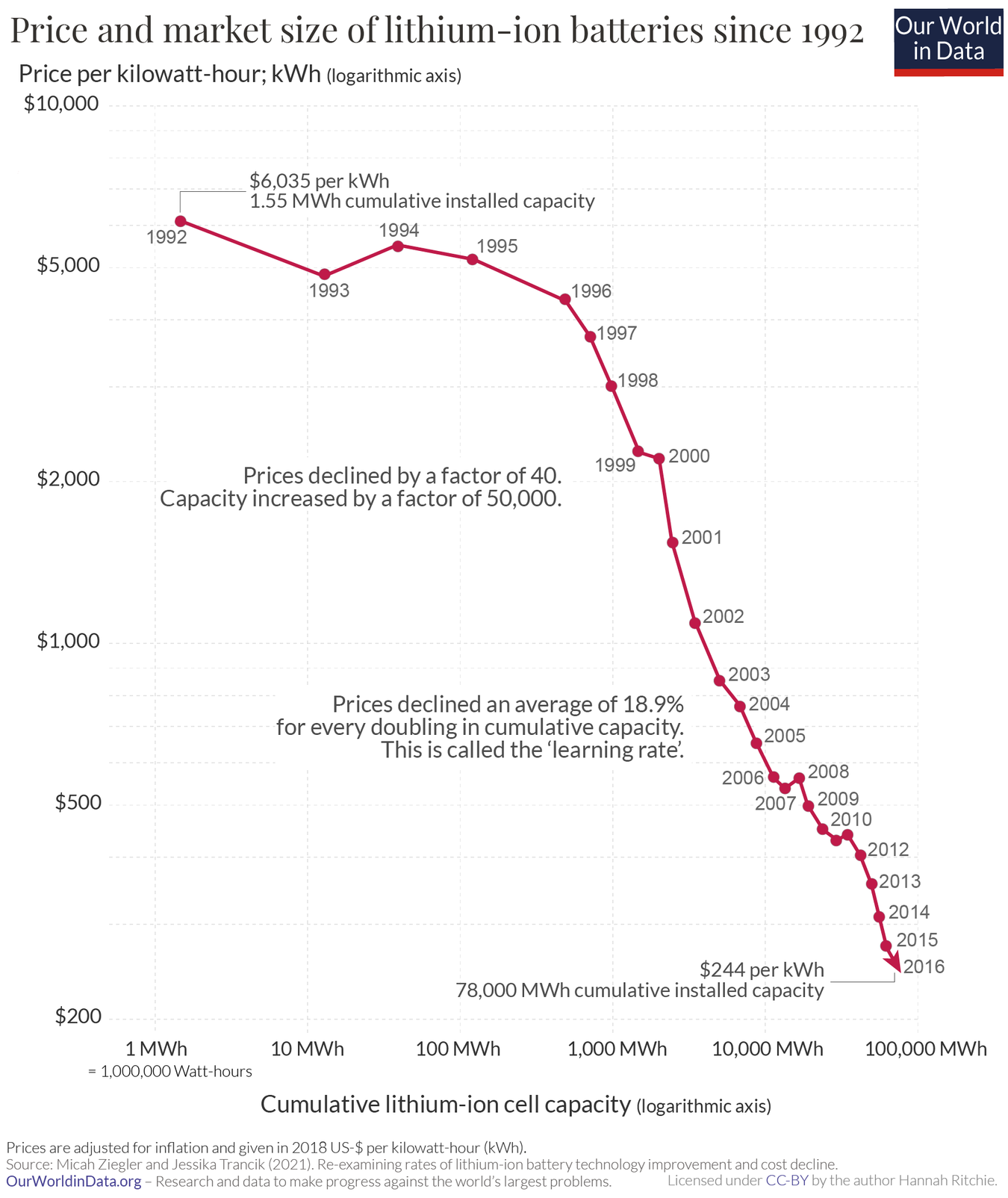- cross-posted to:
- environnement@jlai.lu
Solar now being the cheapest energy source made its rounds on Lemmy some weeks ago, if I remember correctly. I just found this graphic and felt it was worth sharing independently.

Imagine how steep that line would be if the fossil fuel lobbies hadn’t been fighting it tooth and nail all these years

much more important: we’d be years ahead with storage technology.

I could be wrong but I don’t think there’s any evidence that the fossil fuel industry worked to suppress storage research/funding. Pretty much every IT industry has a huge interest in improving battery tech and energy storage in general, it’s just that we’ve already hit all the low hanging fruit from a chemistry standpoint

I remember hearing stories about oil companies buying up battery patents. But this may be because they want to collect the royalties, not necessarily to suppress any kind of research. But like you said, I don’t think there is any evidence… But if they were suppressing the technology, we probably would never know about it.

My dad was a VP at an oil major and has a literal story of an LNG tech being bought and shelved. Yet he’s still just like the people he complains about in that story. They’re a strange generation, these boomers.

Gotta keep prices high yo

It would be less steep because solar costs would have come down earlier.

That would make it steeper, no?

This part of the graph (2009-2019) would be less steep, because this sharp drop would have happened earlier - we’d be further along the curve

Without saying anything about politics, environment, or source:
Why, for the love of Satan, does this graph have only 2 data points per source?
Why use a line chart 📉 for that?
This is clear bar chart territory 📊.

I know it’s not ideal, but a bar chart design could either focus on the difference over time for each source, or the difference between sources at each time. This plot gives a good representation of both the differences between sources and the change in time for each source. It really drives home how far solar prices have fallen relative to other sources and in absolute terms.

It’s called a slope chart and it has several benefits compared to bar charts:
- https://datavizproject.com/data-type/slope-chart/
- https://seeingdata.org/taketime/inside-the-chart-slope-graph/
- https://www.storytellingwithdata.com/blog/2020/7/27/what-is-a-slopegraph
I for one think this is much better than using a bar chart for this use case, as the angled arrows make it immediately obvious the information that matters the most here (the rate of change) while still keeping it contextualized (by relative positions). The bar chart version of this would inevitably look more cluttered and would not be more effective in conveying the incredible progress in solar costs.

Pretty clearly shows why there’s no future for nuclear power.
Even for filling gaps in renewables, peaker plants are getting cheaper and don’t take 15 years to build.

And it is always a question how they calculated handling of nuclear waste.
There are options, we can use coal and natural gas for on demand power to fill the gaps in renewables, we don’t have to quit all at once. New ideas for energy storage and comming around, some of them might be useful for small towns, others for remote places.

nuclear waste, by definition of being radioactive, is the only wast that goes away on it’s own if you leave it sit for long enough
I was considering whether this is just a shitpost, but your other comments suggest that you’re completely serious. It does not go away. Radioactive decay causes multiple transitions between radioactive elements until it ends up as lead, which does not decay further.
Of course, it should also be said that it’s better to have no waste than waste that eventually turns into lead.
And that it’s still better to have waste than waste which also happens to be toxic.
right, but when it lands at lead it’s no longer radioactive waste, which is the part everyone’s scared of. chemical waste doesn’t just go away like that.

I think that’s too simplistic of a view. Part of the high cost of nuclear is because of the somewhat niche use. As with everything, economies of scale makes things cheaper. Supporting one nuclear plant with specialized labor, parts, fuel, etc is much more expensive then supporting 100 plants, per Watt.
I can’t say more plants would drastically reduce costs. But it would definitely help.

They’ve had 75 years to get the cost down. It’s still going up.

because of oil funded fear pushing pseudoscience based restrictions
The source article actually talks about this and measured data suggests nuclear cost actually went up, despite more capacity being built.
This is the first time, I’ve read this anywhere. More sources/studies would be really important. And there is lots of interpretations to be had on the why, but assuming the article isn’t completely off the mark, that’s cold, hard data suggesting that your (perfectly reasonable) assumption is actually wrong, after all.

Interesting, I’ll have to look at the source article.
But as far as I’m aware the total amount of nuclear power has been decreasing in recent years. This might change with China’s future plants.
I’ve also read about small modular reactor designs gaining traction, which would help alleviate the heavy costs of one off plants we currently design and build.
Not saying the source is wrong, just saying that’s what I used to form my opinion.

china’s been building dozens of reactors, all of a common design which is the correct way https://en.wikipedia.org/wiki/Hualong_One

bullshit regulatory costs can increase infinitely without nay change to the underlying engineering or economics. that’s 100% the cause of the price increses
Possible. But well, whether these regulations actually are bullshit or not, kind of doesn’t matter. A dumb solar panel won’t ever need to be regulated as much. If that’s what makes it cheaper, it still is cheaper.

Dang, it’s almost like it was worth all the research money the government crammed into it in the long run, unlike what my dad said to me a million times.

The installation just keeps getting higher. Now to add onto mine I need a load of additional equipment that was not required when my first lot of enphase inverters was installed. Also what was quoted for the labour and materials that are not the panels and inverters has almost tripled in 4 years. Have to get the roof sorted before I go ahead with it and the higher output panels and inverters mean that I would get about another 1.5kw in the same space compared to my first installation.

Rooftop solar is the most expensive way to do it. The graph above is for utility scale systems. Roofs are always custom jobs and they’re priced accordingly. Utility scale uses racks that are all the same for an entire field.
If rooftop was priced alone on the chart in OP, it’s be around the price of nuclear.

To ballpark some numbers on the contractor side, I charge about $100/hr to install it now - 4 years ago that might have been $60/hr.

Is this just the cost per raw Watt produced?
Is it a fair comparison vs conventional fuel-based power (coal/nuclear)?
Ie: if you wanted to build a plant capable of producing continuously, 24 hours a day, you would need some multiple of solar panels to produce an excess during daylight, and storage.
Not that drastic drops in solar costs aren’t bad, just what would the cost-per-watt be if you had to power an average city on just solar for a year?

Look at the subtitle on the chart, it’s levelized cost over the generator’s lifetime. So not including storage for any intermittent source like solar or wind

And not including the financing cost of buying up an this upfront.
I’m buying 36kWh solar array and it will be home made diy, used.parts and maximum jank and don’t paid upfront because that’s the only way it makes economic sense and that’s hoping it works for more than 7 years (break even point at my insolation level and and grid price (8.8$cad/kWh) and it only works with net metering)

Well you’ll never get a “fair” comparison, because the environmental effects are never properly priced into the consumer price.

Government subsidies work for getting new technologies out of the prototype stage and into practical deployment. Solar and wind are both good demonstrations.

I know it’s basically a physical impossibility but here hoping to another 89% in the next 10 years (compared to today)

It’s frustrating seeing a graph showing the price of electricity going down while my utility prices go up. Does this take into account infrastructure cost?

Are the renewables including cost of storage in this graphic? Batteries are a lot more needed with wind and solar since they aren’t always available.
Also, I’d imagine nuclear would enjoy a similar level of success if there were more countries willing to invest in nuclear.

Let’s add in the cost of batteries as their own thing, because they can be charged from anything and are far cheaper than other sources promoted as covering for gaps in renewables.

Let’s add in the cost of batteries as their own thing
I don’t know if this is a fair thing to do. Yes, we could charge it from any other source, but we aren’t (intentionally) overgenerating power from sources like coal, gas, etc. Thus, the need for implementing that storage largely depends on renewables.
I also feel like factoring out the costs of storage implementation leaves more gaps for combustion generation supporters to criticize renewables. I would rather be honest about the upfront costs and instead emphasize the long term benefits of renewables, both in cost and cleanliness.
As far as I understand the description at the top of the image, no, storage is not included. But if production costs are insanely low, that of course does leave plenty room for storage or redundancy. In particular, personally I believe the costs will continue on a logarithmic drop and we’re at the steep part of that, so even if it really is not the case today, I do expect solar production + storage to become cheaper in a not too distant future.
Also, as another graphic from the source article illustrates, battery costs are rapidly dropping, too:




The price of electricity produced is an interesting metric to look at but can be very misguiding alone without more data around it.
It like comparing the price of rain water compared to well water.
The same way that solar is cheaper than nuclear, rain water is much cheaper than well water, you just need a roof with a gutter to get rain water.
Does it means that we should stop using wells and rely only on rain water and use water only when it rains ? Or do we also want to have tanks, do we need a backup for when the tanks are empty ? …
Yeah, there may be situations/regions where even the cheapest solar isn’t good enough. But at some point, the cost difference does become an oppressive argument. Even at that price in 2019 already, you can use around 75% of your money to build storage or redundancy in multiple regions / with alternative renewables.
And this trend of cost reduction for solar will very likely continue, even if it might start levelling off at some point.

It doesn’t matter how cheap solar is. Fossil fuels are still more profitable, because once a fossil fuel plant is built, it needs fossil fuel to run. You can’t do the same with sunlight. We literally cannot shift away from fossil fuels under the current profit driven model.
More profitable for fossil fuel companies, sure. And they will lobby to stay in business.
But no one needs fossil fuel companies. If you can sell 1 MWh power, that’s a fixed amount of income. If you have less costs to cover (what the graphic shows), then that’s more profit for you.

I’m speaking from an American perspective, but what you’re describing is part of the problem. Power companies are legally not allowed to make a profit from selling electricity here. They make a profit from the government giving them money to expand their services (this model was developed following world war 2 to encourage post war growth).
Again, under America’s current model, solar is not profitable, especially not for large corporations.
Hmm, interesting. Here in Germany, power companies are partially privatized and I always thought, whomever came up with that nonsense took inspiration from the turbo-capitalism in the USA. Apparently not.
Do they need to be profitable, though, in your model? It mostly sounds like a traditional public service, where the government could just tell them to use the money for solar…

The power companies here are privately owned, and America has a lot of laws dealing with what the government can and can not tell private companies what to do. Most of the laws deal with what the government cannot do. Basically, the company sells electricity at cost, then sends the government a letter that’s like, “Hey, we need $$$ for repairs, upgrades, and stock holders. Here’s all the upgrades we want.” And the government is like “Sure, this is America, gotta turn a profit,” and gives the utility companies whatever they ask for. Then the utility companies just give all the money to the stock holders, perform the bare minimum repairs to operate, and just lie to the government about what they did with the money. There is an especially egregious case in South Carolina where a utility claimed for years that they were going to build a nuclear plant to help meet energy demands in the area. Well after an audit, turns out the owner just pocketed all that money. That guy was punished, but see how bad it has to get before anything happens?
This video does a much better job at explaining it than I ever could. It’s long, but they explain how utilities make a profit in the first 15 mins. https://youtu.be/2n_au5Hje_E?si=S9e8o7QQpFjueZta

Price of onshore wind is about as low as solar.
I’d like to add wind to my solar eventually. Multi-modal makes a lot of sense to me. Pretty sure my solar installers don’t do that and I have no idea who does do that…if anyone. I’ll investigate someday.

There is no home wind power industry because unlike solar, wind power is only cheap when you go big.

To be fair home solar is also not $89 for a Mwh. Least not here.

